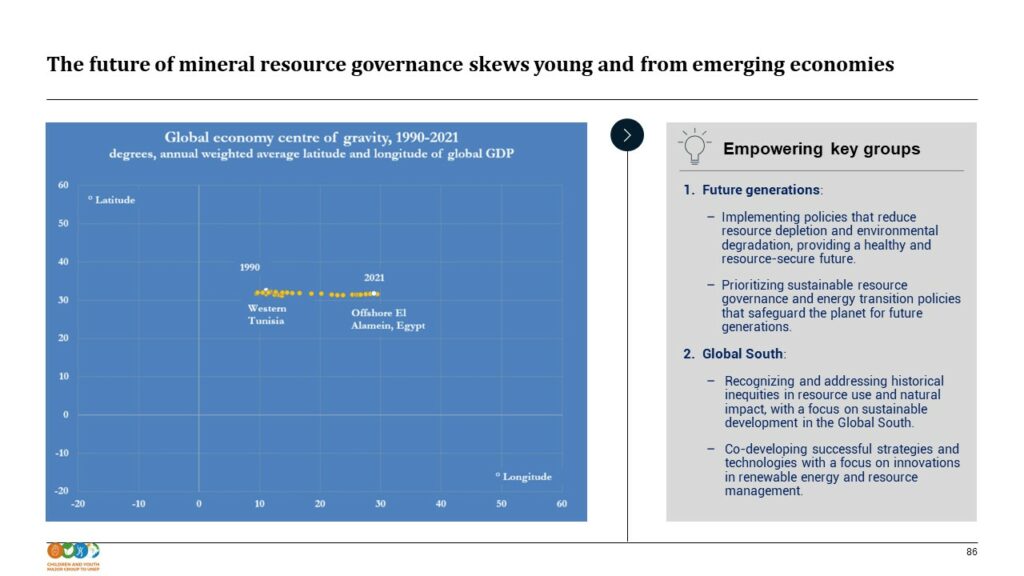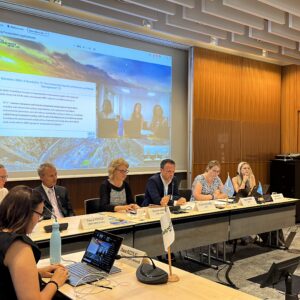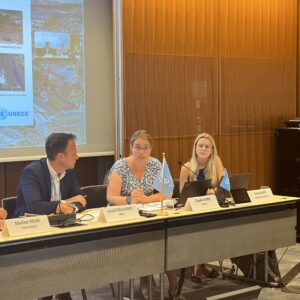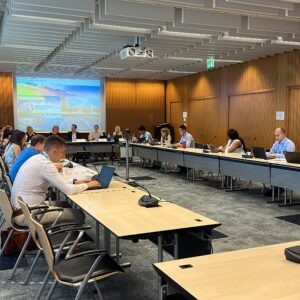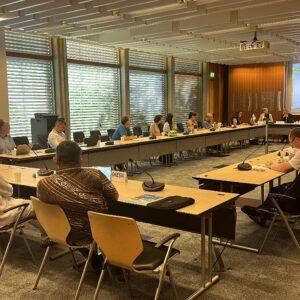Event Conference
Briefing on the Global Intergovernmental Meeting on Minerals and Metals

23 Aug 2023
11:00–12:30
Venue: International Environment House II (Chemin de Balexert 7-9, Châtelaine) & Online | Webex
Organization: Switzerland, Pakistan, Geneva Environment Network
The 5th UN Environment Assembly (UNEA-5) adopted Resolution 5/12 on the Environmental aspects of minerals and metals management and requested the convening of intergovernmental regional consultations, followed by a global intergovernmental meeting. This event, held two weeks ahead of the intergovernmental meeting, taking place on 7 and 8 September 2023 in Geneva, was organized in collaboration with the co-chairs of this process within the framework of the Geneva Environment Network, provided updates on preparations and the way forward.

About the Event
Minerals and metals play a central role in the global economy, as they provide the raw material we need for industrial processes and daily use. Despite enormous efforts to decouple economies from resource use, the extraction of mineral resources has increased markedly in recent decades and, over the last decade, at a faster rate than economic growth. As such, unsustainable extraction, manufacturing, use and disposal of resources are having important detrimental impacts of people and the planet.
At the 5th UN Environment Assembly (UNEA-5), delegates discussed this important issue and adopted a resolution on the Environmental aspects of minerals and metals management (UNEP/EA.5/Res.12). Building on the UNEA-4 resolution on the matter, Member States stressed the “need for enhanced action to support the environmental sustainability of the management of minerals and metals” along their full lifecycle. The resolution requests the convening of intergovernmental regional consultations, followed by a global intergovernmental meeting, to develop non-prescriptive proposals to enhance the environmental sustainability of the minerals and metals along their full lifecycle, to be held in Geneva, where many organizations are actively working on issues related to resources governance.
The Global Intergovernmental Meeting on Minerals and Metals will take place on 7 and 8 September 2023 in Geneva, back-to-back with the 2023 edition of the World Resources Forum. It follows a series of intergovernmental regional consultations dedicated to stocktaking existing activities and actions in the public and private sectors to enhance the environmental sustainability of minerals and metals, held in 2023.
This event, taking place two weeks ahead of the intergovernmental meeting, provided updates on preparations and the way forward.
Speakers
By order of intervention.
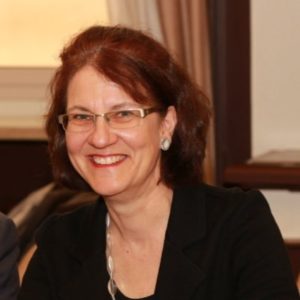
Martine ROHN-BROSSARD
Deputy Head, International Affairs Division, Federal Office for the Environment, Switzerland

Elisa TONDA
Chief, Resources and Markets Branch, UN Environment Programme
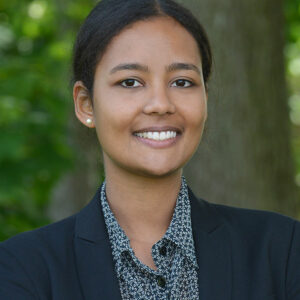
Charlotte NDAKORERWA
Programme Management Officer, UN Environment Programme

Gabriela ENCINA VERA
Chief of Sustainable Development Division, Ministry of Mining, Chile

Khadija DRAME
Deputy Coordinator of Legal Affairs Unit, Ministry of the Environment and Sustainable Development, Senegal

Claudia KAMKE
Environmental Affairs Officer, Convention on the Transboundary Effects of Industrial Accidents, UN Economic Commission for Europe
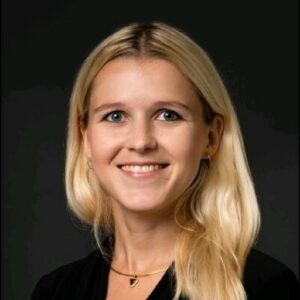
Teresa MAYR
Legal Officer, Aarhus Convention Secretariat

Pascal PEDUZZI
Director, UNEP GRID-Geneva

Gyubin HWANG
Global Focal Point, Children and Youth Major Group to UNEP

Inga PETERSEN
Executive Director, Global Battery Alliance

Jon Angelo BONIFACIO
Spokesperson, International People's Conference on Mining
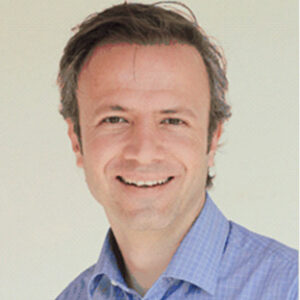
Arnold KREILHUBER
Director, Europe Office, UN Environment Programme | Moderator
Video
Live on Webex
Live in the room
Highlights
Summary
Moderated by Arnold KREILHUBER | Director, Europe Office, UN Environment Programme
We welcome everyone to this briefing on the important intergovernmental meeting on minerals and metals, both in-person and online. We are very fortunate to hold this meeting in Geneva where many relevant stakeholders for this issue are conducting their work.
Today’s event will provide an overview of where the international community has come so far with the process, mandated by UNEA resolution 5/12. It will give different stakeholders and Member States to provide their input, considerations, and perspectives on this issue.
Opening
Martine ROHN-BROSSARD | Deputy Head, International Affairs Division, Federal Office for the Environment, Switzerland
As co-chair of this important process, it was a big honor and humbling as I went to different UN regions [for the regional meetings] and we could really see the diversity of needs.
With regards to minerals and metals, Switzerland is dedicated to this theme: though we don’t have so many metals and minerals as in all in other parts of the world, we are also consumers. As consumers, we are also a part of the life cycle value chain.
In the triple planetary crisis of climate change, biodiversity loss, and pollution, finding a solution to the climate crisis needs more sustainable energy. However, this sustainable energy needs a lot of minerals. We have to be careful not to shift the climate crisis to a resources and minerals crisis.
Regional consultations with the co-chair from Pakistan had such rich discussions with countries. They were very engaged: we have now about 120 national focal points on this subject. We hope we will get more, but it’s already a lot of committed countries. We had also very good discussions with stakeholders and international organizations with us on the whole journey.
This journey will continue because we see common links, for example, for an assessment on standards. We see links with a Sand Observatory, with tailings issues, with small-scale mining, among others. We had a lot of proposals that are available on the GGKP website.
With the global meeting taking place on 7 and 8 September, all these countries all together will have the opportunity to exchange about these proposals, alongside stakeholders. With these, we can probably see what we can prioritize to put forward for the next UN Environment Assembly. The journey will not end with UNEA6 but will continue with perhaps a working group dedicated to some specific issues to continue the discussion.
Elisa TONDA | Chief, Resources and Markets Branch, UN Environment Programme
Context | We are operating in the context of a UNEA resolution approved in 2022 that focuses on the environmental aspects of minerals and metals management across their full life cycle.
There are three aspects that help us see why it is so critical now that the resolution has mandated a specific process and other activities.
- One element of the context that stresses the importance of these process is highlighted in the resolution: Member States are acknowledging that clean technologies that are so important for the clean energy transition for a green economy are highly dependent on minerals and metals.
- The context set in the resolution also addresses the important contribution that an environmentally sustainable management of minerals and metals makes to the achievement of the 2030 Agenda for Sustainable Development.
- This context is also underpinned by a recent brief policy brief from the UN Secretary General that stresses the importance of the issues that we have at-hand. The policy brief reminds us that mineral resource extraction plays a dominant role in the economies of 81 countries. Those countries account for a quarter of global GD, half of the world’s population, and nearly 70% of those living in extreme poverty.
Finally, the mining and metal sector is extremely important if we are to advance in our fight to address the three crises of pollution, biodiversity loss, and climate change, a central pillar of UNEP’s medium-term strategy until 2025.
Mandated requests | With this context, three specific requests were put forward to the UNEP Executive Director:
- A request (reflected in its second operating paragraph) to convene transparent and inclusive intergovernmental regional consultations to fit into a global intergovernmental meeting with the aim of developing non-prescriptive proposals to enhance environmental sustainability of minerals and metals across their full life cycle. These operating paragraphs will be very much the focus of our conversation and a lot of the elements of that mandate have a very critical importance vis-à-vis the discussions we will be having.
- The resolution adds two more mandates one of which being around strengthening scientific, technical, and policy knowledge about supporting global policies and action in relation to environmentally sound extraction and use of sand.
- Another mandate is around the compilation of a report on knowledge gaps in relation to environmental aspects of tailings management.
The conversation today will be focusing on the intergovernmental process that unfolded and that will conclude in a couple of weeks’ time at the Global Intergovernmental Meeting taking place in Geneva on 7 and 8 September. A very clear objective is going in-depth into what we have learned in the regional consultations and provide an opportunity to Member States and stakeholders to further discuss and refine as non-prescriptive proposals, as referred to in the resolution.
Update on Preparations: Outcomes of the Regional Consultations and Presentation of the Background Document for the Intergovernmental Meeting on Minerals and Metals
Charlotte NDAKORERWA | Programme Management Officer, UNEP
Objectives and expectations | The upcoming global intergovernmental meeting will address the mandate of the resolution which has just been outlined. We’ll further develop and refine non-prescriptive proposals that Member States and other stakeholders have already put forward during the regional consultations, but also through written submissions that we have been receiving.
The outcome of the meeting will be a co-chair’s summary which will be available shortly after the meeting, as well as a progress report of the UNEP Executive Director which will be put forward at the next session of the UN Environment Assembly in February 2024. We expect that during the global meeting all participants will engage actively on the mandates of the resolution to further discuss, refine and maybe even prioritize some of the non-prescriptive proposals.
Detailed structure of the meeting | The meeting will take place on 7 and 8 of September at the International Conference Center in Geneva. It will be a two-day hybrid meeting allowing for in-person and online participation. It will be facilitated by the two co-chairs from Switzerland and Pakistan. We will also be providing interpretation into all six official UN languages throughout the meeting.
The meeting is open to Member States, and as mentioned, Member States have nominated national focal points to engage in this process. International organizations, MEAs, and accredited civil society organizations can participate as observers. Registration for the meeting is still open until 1 September and we are providing funding for one representative per eligible member State, as well as a few accredited civil society representatives.
Background document and non-prescriptive proposals | We have developed a background document which will provide further guidance for the global meeting. It provides an overview of the outcomes of all regional consultations, as well as an analysis of the written submissions that we’ve received.
We had around 38 non-prescriptive proposals that were developed in the five regional consultations that were held between April and July. We had around 30 written submissions received from Member States as either individual or joint submissions and contributions from other stakeholders what we have done in the background document. We analyzed the non-prescriptive proposals which were very broad as they leooked at the entire life cycle of minerals and metals, and included topics such as artisanal small-scale mining, sand, tailings policies, among others.
We have grouped them into three thematic clusters: policy and tools, minerals and metals along the entire life cycle, and on platforms for international cooperation. The background document outlines all of the 24 non-prescriptive proposals and how we’ve clustered them in the three clusters,
Agenda | On Day One, in the morning, we will open with a plenary which will go more into detail the background document and outcomes of the regional consultations presenting the non-prescriptive proposals, as well as having a panel discussion.
The afternoon of Day One will organize breakout group discussions with all participants according to these three clusters. The discussion and breakout groups will continue in the morning of Day Two to allow all participants to be able to fully engage on all the clusters and allow enough time for that. The breakout group discussions will also be interpreted into all UN official languages.
The afternoon of Day Two will be a report back from the discussions into a plenary, as well as the presentation of the Draft Co-chairs Summary of the meeting.
We also offer the opportunity for side events during the lunch break. We will be able to host two side events in parallel on both days. There will be also a reception at the end of Day One hosted by Switzerland.
Detailed program of the Global Intergovernmental Meeting (click photo to enlarge).
Additional information | The link here gives you the list of all national focal points, which we are updating on a regular basis. If the information is not correct, please feel free to reach out to us and we can correct that in the run-up to the global meeting.
We are organizing a few events and meetings to raise awareness of the resolution, and to also prepare participants to engage in the meeting. Last week, we organized a briefing to UN member states, we have today’s briefing, and we will also be organizing a meeting and briefing for the UN Environment Management Group on 30 August. We are also having a joint event that we’re organizing with World Resources Forum on 6 September.
Stakeholders Perspectives
National Focal Points | Gabriela ENCINA VERA | Chief of Sustainable Development Division, Ministry of Mining, Chile
We had the regional consultation in May 2023 in Santiago, Chile. We had this in a hybrid format with more than 20 countries, observers, and civil society speakers.
e reached eight topics with many proposals: sand, mine tailings, mine closure, public trust and multi-stakeholders dialogue, international best practices, standards and instruments, implementation of Agenda 2030, sustainable consumption and production, and working groups.
Most of the main proposals were to establish a Global Sand Observatory. On mine tailings, to establish national focal points to follow the implementation of the global industry standards for tailings management.
In mine closure, the establishment of closure criteria and environmental social economic guidelines for mine closure based on indicators. In in this region, we have many differences between countries. On public trust, we propose to support the implementation of Escazù Agreement and develop the dialogue mechanisms, and regional or national policy dialogues with all stakeholders, including with the support of the UN.
Regarding international best practices, we propose several things about the collection and updating of these best practices, assessments of graphs and prioritization in line with the triple planetary crisis, and support for how to apply such measures on the national level, and explore the idea of an international agreement to support environmental consideration in mining, as in the update of national legislation.
With regard to the working group, we propose to establish an expert working group on mineral and metals sustainability composed by national focal points and observers to follow up on the non-prescriptive proposals. We also propose to create a Latin American and Caribbean network of experts on mining and sustainability.
In Latin America and the Caribbean, we have many differences in legislation: some countries are already looking for new legislation while others do not have any. These proposals are aimed to [address such differences].
National Focal Points | Khadija DRAME | Deputy Coordinator of Legal Affairs Unit, Ministry of the Environment and Sustainable Development, Senegal
The intervention was originally presented in French. Presented here is a rough translation of the intervention.
Senegal thanked the co-chairs and the UNEP team for the support provided for the regional consultation in Senegal for the African countries. The consultation had the participation of 27 Member States who shared ongoing activities of States and the good practices that are already implemented.
Especially for the African continent, an important problem is the management of small-scale mining as this type of exploitation creates a lot of mining waste. There are not enough installations for the treatment of this waste.
On the outcomes of the consultation in Senegal, Member States almost unanimously welcomed the idea of having an observatory for sand. The African continent is very engaged in the idea of having this observatory.
Another idea that came out is the global evaluation of existing instruments for mineral resources. It is important to have an idea of where we need to act, and the need for the reinforcement of international cooperation. To her, African states are not readily equipped to deal with these problems of the environmental management of mineral resources and their waste and will need some assistance. The global submission of all the African continents that was made on 3 July.
She attended the 19th session of the African Ministerial Conference on the Environment that took place in Addis Ababa from 14-18 August 2023, with thanks to the Swiss who funded her participation. In the meeting, she managed to integrate the mention of resolution 5/12, which was then integrated in one of the decisions of the Conference on the critical minerals for the energy transition.
Tailings Safety | Claudia KAMKE | Environmental Affairs Officer Convention on the Transboundary Effects of Industrial Accidents, UNECE
Tailings management facilities (TMFs) already pose huge risks to people, the environment, and economies today but these risks will grow significantly.
Key challenges | Not in a faraway future but in this decade because of the increasing need for energy transition the green transition which will also mean an increasing demand for critical raw materials. This will create potential shortages, trade dependencies, and geopolitical challenges. It also means that there will be an increasing number of tailings management facilities and related risks.
However, we need to know these hazards and risks from tailings management facilities to be able to manage them. Currently, there is a lack of knowledge about TMFs: the number, their location, their state and conditions, possible transboundary effects that they may have, and how to effectively manage the risks from tailings management facilities within and across countries.
There’s another pressure factor and that relates to climate change. We can expect more frequent and severe weather events, causing more natural disasters. We already see that now that these will also increase the risks for potential TMF failures and transboundary effects. In order to manage these challenges and to achieve the SDGs, it will be key for countries to strengthen their efforts and the increase the pace towards sustainable resource management and tailing safety.
Transforming mining and processing industries | UNECE has well-established frameworks in place to help countries transform their mining and processing industries. For example, the UN Framework Classification for Resources (UNFC) and the Resource Management System (UNRMS) can help reduce waste, use tailings, and other secondary sources, and create value-added products. As such, they promote resource efficiency, environmental sustainability, social responsibility, and green financing.
ECOSOC has endorsed a UNFC and UNRMS for global application and these frameworks and tools are also being promoted by the European Union, by the African Union, and by many other countries worldwide.
UNECE Industrial Accidents Convention | The UNECE Industrial Accidents Convention is a legal instrument that helps countries strengthen their tailings safety and governance. Many guidance and materials and tools have been developed under the framework of the Convention and they are available for use by all UN Member States: TMF safety guidelines and good practices to support the practical implementation of these safety guidelines; the TMF Safety Methodology that countries could apply on the ground; policy documents such as the Roadmap and a Decision on strengthening mine tailing safety; and an online toolkit and training on tailing safety.
These guidance materials and tools have been applied in practice in several in many UNECE countries throughout the region. This resulted for example in the development of inventories and maps of tailings management facilities, for example, 580 TMFs for the Danube River Basin and in Central Asia, among others. This has resulted in the conduct of on-site trainings at TMFs to build capacity and better understanding of the risks. Several countries created inter-institutional working groups on tailings safety and the prevention of accidental water pollution. It also strengthened sub-regional and transboundary cooperation on tailing safety and governance.
2030 UNECE Road Map for Action on Tailings Safety | The implementation of the roadmap can boost also the implementation of the UNA resolution 5/12. UNECE countries agreed in this roadmap to strengthen tailing safety and governance in the following areas.
Key messages: From regional to global consultations | UNECE has been presenting at all regional consultations on the subject of tailing safety, and we would like to present a few key messages here as we go towards the intergovernmental meeting in September.
- Life-cycle approach & sustainable resource management are important to manage the green transition and achieve SDGs
- Need for global mapping and assessment of existing legal & policy instruments that apply to environmental aspects of minerals and metals (and related guidelines and tools, g. UNFC & 2030 Road Map)
- Strengthening safety & governance and preventing accidents at all TMFs, including abandoned, active, inactive, future, etc., are key for protecting people, environment & economies
- Important to take integrated risk management approach, including to address impacts of climate change & natural disasters (Natech risks), for enhancing safety measures & reducing risks
- Need for more cooperation and coordination to address TMF hazards and risks, including transboundary risks, at national, cross-border, regional & multistakeholder levels (e.g. IIWGs)
- Need to fill technical knowledge gaps through TMF mapping, risk assessment, capacity building & IO cooperation
- Reporting & regular information exchange on lessons learned and good practices across countries & regions are valuable for respective environmental processes
- Tailings management facilities pose huge risks to the nearby and riparian populations. It will also be important to inform them and involve them involve those that are affected on the other side of the border.
More information available in the presentation.
Public Participation | Teresa MAYR | Legal Officer, Aarhus Convention Secretariat
We see this meeting as a great opportunity to discuss how the rights under the Aarhus Convention can significantly contribute and also support the environmentally sound management of minerals and metals.
Introduction to Aarhus Convention | The Convention on Access to Information Public Participation Decision-Making and Access to Justice in Environmental Matters was adopted in 1998 in the city of Aarhus, Denmark, (another name the Convention is known for) and entered into force in October 2001. Currently, the Convention has 47 parties from across the Eurasia region with different economic, societal, and political backgrounds, and one country from Africa Guinea Bissau which has very recently acceded to the Convention. The European Union is a party to the Convention as well as its Member States.
The convention is a global treaty, which means it’s open to accession by any UN Member State. It has also served as a model for instruments in other regions: Escazù Agreement in the Latin American and the Caribbean region.
Obligations | As to the substance of the Convention, it rests on three broad pillars and enshrines legally binding obligations in relation to these, namely: access to information, public participation and environmental decision-making — the pillar I’ll focus on today, which includes public participation in international forums — and access to justice in environmental matters.
There are also two additional obligations worth mentioning in this context:
- Article 3/8 of the Aarhus Convention which provides legally binding obligation to protect environmental defenders from penalization, persecution, and harassment. The Aarhus Convention was the first international instrument that included such a legally binding obligation on States. In 2021 the Aarhus Parties adopted decision 7/9 which created a rapid response mechanism to deal with cases under article 38. In June 2022, the Aarhus Parties elected the first Special Rapporteur on environmental defenders under the Aarhus Convention, Michel Forst, who receives complaints for violations of article 3/8.
- This is important and topical in this context considering that when we look at reports that we receive from NGOs, some of the most serious cases of penalization and persecution of environmental defenders arise in the context of extractive industries.
- The second obligation outside of those three pillars is article 3/9 which imposes direct obligations on States not to discriminate based on citizenship, nationality, or domicile. In practice, that means that in relation to all three pillars, all persons, regardless of a region have the same rights as people living in one of the Aarhus countries parties.
On public participation | Articles 6, 7 and 8 of the Convention provide public participation requirements for decision making in relation to activities, plans, programs, policies, and legislation, including those relating to the extractive industries. With respect to activities including mining licenses, extraction permits, and any activity where environmental impact assessments with public positive participation that are required in national law, the Convention provides a number of obligations: ensuring early adequate and effective notice of the proposed activity; reasonable time frames for public participation while options are still open; access of the public to order relevant information; the right of the public tools to submit comments; on the public authority, to take to account of those comments; and finally a prompt notice once a decision has been made. If the activity is somehow updated or operating conditions are changed, this process of public participation must be repeated as appropriate.
With respect to the preparation of plans, programs, and policies relating to the environment – for example, a program or a policy for the sustainable management of metals that may have a significant effect on the environment – articles 7 and 8 provide a subset of obligations of public participation.
Those are the extensive requirements in relation to the domestic and transboundary context. um however as I mentioned at the beginning um the
Promoting the principles | The Aarhus Convention also imposes an obligation in relation to public participation in international forums. Under article 3/7, parties are required to promote the principles of the Convention and international decision making within the framework of international organizations in matters relating to the environment. This means an Aarhus Party engaged in UNEA or a possible future multilateral environmental agreement on the sustainable management of minerals and metals has an obligation to promote the rights under the three pillars of the Aarhus Convention.
In 2005, the Parties to the Convention also adopted the Almaty Guidelines which provide general guidelines on how the whose Parties are meant to promote these principles in international forums. It provides a very useful guidance document for States to understand the obligation under article 3/7 of the Convention. This is directly relevant in the present context of both the upcoming global intergovernmental meeting and any future steps in the development of frameworks to enhance the sustainable management of minerals and metals.
Aarhus Parties should bear in mind the obligations under the Convention in that regard and furthermore the Aarhus Secretariat also cooperates with Secretariats of international fora to assist in promoting the effective public participation in international decision-making.
Sand | Pascal PEDUZZI | Director, UNEP GRID-Geneva
This question of sand is impressive: in my hand are two things that we use most, water and sand (with which glass is made). We don’t tend to think that sand is such a big thing, but we use 18kg of sand per person, per day.
In 2020, the weight of all the infrastructure that we’ve been building (concrete, asphalt, all built material roads and so on) have exceeded the weight of the dry biomass (the weight of the entire vegetation of planet Earth). It is impressive that humans have come to this level of modification of planet Earth. Every year, we’re using 50 billion tons of sand and gravel – enough to build a wall 27 meters high, 27 meters wide around equator every year.
This has tremendous impact on the environment, depending on where it is taken. For example, beaches after just one day of operation will weaken its role in protecting us against storm surge. It also causes salination of aquifers, prevents the touristic development of this beach, and impacts biodiversity. Taken from rivers, you will change the beds of the rivers affecting river flows and turbidity, affecting the fauna. Taken from the marine environment, vessels that looks like a giant vacuum cleaner will sterilize the bottom of the sea and reject fine particles that change the turbidity. All these microorganisms have been crunched and do not feed the fishes anymore, impacting biodiversity and fissuring.
We don’t tend to see sand as a strategic material, but we should as our entire society is built – it is in concrete, wall, windows, roads, bridges, hospital, schools, etc. Nothing could be built without concrete, which comes from cement, which consists of sand and gravel. From solar panels to dams for hydropower, it’s also for energy renewable energy. We will need a lot of sand now.
We also need sand for the aquifers. We tend to think of them as a bunch of water, but these are small cracks between sand and gravels where we are pumping the water. We depend on sand for protecting our shoreline to support biodiversity needed for the work that we do. It’s a strategic material.
UNEP has been publishing four reports on the question of sand, and this has led to several international resolutions and motions. One is UNEA resolution 4/12 that requests GRID-Geneva within UNEP to strengthen the scientific, technical and policy knowledge regarding sand. We have also published the report, 10 Strategic Recommendations to Avert a Crisis on Sand, but one of the proposals we have submitted to the member states in all resolutions during the regional consultations was to create a Global Sand Observatory.
We have an observatory on energy, water, biodiversity, and on many things, but strangely enough the second material most used by humans next to water has no observatory. As a result, we don’t know exactly how much of it we use, what are the impacts, how we could best improve these extractions, and reduce the impact, etc. The proposal is to create this Global Observatory, not as a full center, but to use an existing organization and to create a small secretariat that will coordinate a network of partners already working on this issue.
We’re taking back from the resolution the three different pillars highlighted: science, technology and policy. We propose three working groups: on science, it would be about monitoring, creating data, looking at the impacts, bringing data and transparency on where sand is being extracted in marine environments, in river environments, on terrestrial environment.
The second working group would be on policy and standards, looking at the existing policies, successful ones. We could be inspired from other countries that want to improve their policies also looking at industrial standards, how we can extract sand while limiting the impact on the environment, how to improve the building standards to use less sand, and to push the development agencies like the World Bank and others on when they are financing large infrastructure to make sure that the material comes from sustainable sources.
Third group will look at solutions: technology, how can we improve our technology to reduce sand, to substitute with other types of material, to think differently, so that we don’t need as much sand.
This small secretariat is what we’ve been proposed. The African region was really the one that was calling for this. We had a really good support as well for this. That will be decided in a few days in the global consultation.
At the World Resources Forum, we’re going to launch our platform for monitoring the extraction of send in the marine environment, which will be part of the working group one of those Global Sand Observatory. We’ve been training an artificial intelligence for detecting vessels dredging sands worldwide from 2012.This would shed more transparency on this very important issue.
Youth | Gyubin HWANG | Global Focal Point, Children and Youth Major Group to UNEP
Working at the Children and Youth Major Group of UNEP means collecting youth voices and bringing them into key intergovernmental negotiations and discussions.
It is important as the global economic center of gravity has changed over the past 30 years. It’s moved eastwards and southwards, meaning that the future of minor resource governance will skew 2 ways: towards the young, and second, from emerging economies. Thus, two groups have to be empowered:
- Empowering future generations, through the implementation of sustainable development policies and resource governance.
- Empowering the Global South, which has traditionally not been able to see the fruits of its resources, to develop renewable energy and resource management through successful strategies and technologies, with a focus on Innovations.
Role of youth | Another important aspect to consider is how we see the youth contribute to enhancing the environmental sustainability of minerals and metals along that full life cycle.
- Advocates for circular economy principles. My colleagues are experts in circularity in governance, in local ecosystems. These groups in most instances, in most countries are the ones taking active initiatives to push these principles forward. They work with local communities, businesses, and industries to ensure that these principles are well understood and acted upon.
- Drivers of technological innovation. As one of the most educated and environmentally literate generations in human history, young people are ideally placed to support a more sustainable extractive sector by research and innovation. A focus on young researchers and on sustainable development is a low-risk high-reward way to ensure that we have a pathway to better technologies to ensure that we can use fewer materials more sustainably with more circularity.
- Negotiators and drivers of policy. We have local and regional consultations to make sure that grassroots perspectives are brought to governments and to intergovernmental negotiations. We call upon you to create platforms for young people to engage with policy makers, industry leaders. This means engaging whenever and wherever possible. I would like to just pose a question and about when you last heard from youth perspectives in the context of mineral resource governance. It is time to encourage young people to speak up on these issues and provide crucial grassroots perspectives on these extremely important emerging issues that threaten communities around the world.
Some ideas and considerations that are important in a heavily commodities-dependent future are presented here. It’s inevitable that we have to have the energy transition which requires mining more materials. At the same time, you have to ensure that these developments are made in the context of sustainable development.
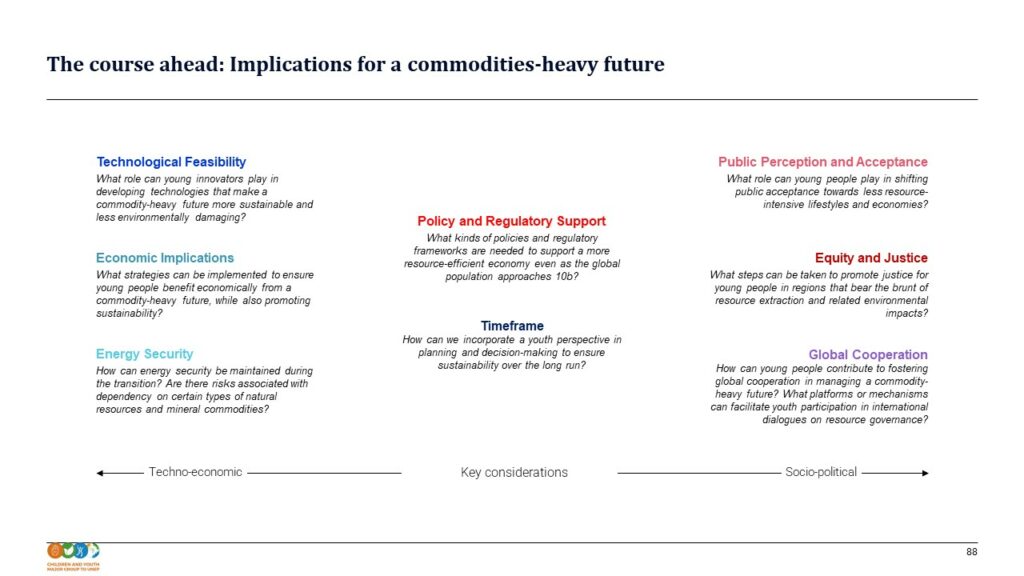
We encourage all of you to think about how to incorporate youth perspectives in planning and decision-making to ensure sustainability not just for the next 10 to 15 years which is about how long it takes to develop a large mind, but 30, 40, 50 years from now. We also encourage you to think about the policy and regulatory frameworks that support a more resource-efficient economy even as the global population reaches 10 billion by 2050.
Private Sector | Inga PETERSEN | Executive Director, Global Battery Alliance
Context | The battery industry is a major consumer participating in the acceleration of extractive activities (including lithium, Cobalt, nickel, manganese but also copper). Looking at all the gigafactories to be built to feed the electrification of the power and the transport sector we need about 380 new mines by 2035, making the impacts of environmental social governance tremendous.
The Global Battery Alliance | I am here today to share a couple of perspectives from that battery ecosystem.
- GBA is a multi-stakeholder partnership initiated by the World Economic Forum as a consequence of that realization of how essential batteries are going to be, especially looking at tansports’s electrification and solving renewable energy intermittency.
- Patterns came together realizing that issues typically associated with battery value chains, many of which are upstream, concern child labor issues (especially in DRC’s cobalt value chains) and the battery carbon footprint.
- A multi-stakeholder partnership was needed to help address these complex issues, and to propose collective action that spans the entire battery value chain independently of governments and mining companies policies.
- The GBA has now grown over 140 organizations and includes some of the world’s biggest mining companies, private sector businesses (Tesla, Volkswagen, recyclers…), NGOs but also with international, public, scientific and academic organizations.
All members have signed up for our 10 key guiding principles structured around a three-fold objective of scaling sustainable circular and responsible battery value chains by 2030. We have worked specifically on Principle 4, reducing carbon emissions, and Principle 8, urgently eliminating child labor from battery value chains.
GBA Battery Passport | To achieve those goals, GBA conceptualized and put into practice a battery passport (later picked up in the EU battery regulation) anchoring in the trend of digital products passports and the demand for greater transparency and accountability across the entire value chain.
The digital product passport will act as a digital twin of the physical battery, and will combine
- The provenance data: tracking and tracing of the material flows from the specific mined it was exploited, through the processing and manufacturing until it is place in the very object
- The technical parameters of the battery (charging rates, temperature, etc.)
- Consistent and comparable reporting on the sustainability performance of the product.
Sustainability Performance | Our definition of a good sustainability performance includes
- Child labor and human rights indices, to set some pathways for companies to address the root causes of child labor in value chains,
- A battery carbon footprint. A greenhouse gas rulebook has been published to calculate each battery footprint in an accurate verifiable and transferable and comparable manner.
Objectives | We launched the world’s first battery pass and showed that it can actually work in practice. Earlier this year, three value chains for three different battery products placed in Audi and Tesla cars reported against these rulebooks to achieve comparable results at the product level.
Verifiable sustainability performance at the product level would soon be a key business differentiator, as illustrated by major battery value chains relocalization around the globe and subsidy packages to achieve sustainable performance.
GPA wants to benchmark the data coming out of the batteries and issue a quality seal for batteries, as no internationally harmonized and comprehensive standards exist at the moment when it comes to defining good sustainability performance across the value chain
Some regions such as the EU are driving this subject from a regulatory perspective, and others will follow (e.g.China). Even though some of them might want to emphasize different requirements for sustainability performance or the rules on how we collect that data, it feels critically important that sustainability performance criteria and data are the same so we can understand each other.
Currently, we are prioritizing the next key indicators to be part of the battery passport: biodiversity, pollution, eco-design, etc.
Conclusion | I will close with an open invitation to all including the government and public sector, to join this process that we’ve kicked off and to support it.
Civil Society | Jon Angelo BONIFACIO | Spokesperson, International People’s Conference on Mining
Engaged in consultations such as one in Thailand on tailings management and sand issues, I realized mining and minerals management has taken on new and complex dimensions. As challenges like the renewable energy transition are coming to the fore, communities across the globe continue to face threats of environmental degradation and human rights violations.
The regime of relentless resource extraction has come to the detriment of communities and ecosystems across the world, and this issue needs to be addressed with the participation of civil society, still not included enough in regional, national, or international level discussions.
Participating in those can become relevant to expound the reality space on the ground, include diverse perspectives, and bring real changes to impacted communities and ecosystems.
Attacks against land and environmental defenders connected with mining projects must be addressed and discussed if we wish to include civil society in discussions around the mining industry.
In the face of the critical juncture of the triple threat, there is a new path we’re hopefully looking forward to. It must be rooted in the approach that puts people and the planet first and this means among many other things genuinely listening to and engaging with the grassroots communities and civil society.
Q&A
Thandi KATHOLO, Botswana Green Building Council: During our assessment, we gathered a lot of data, so existing data exists. Who do we reach out to ensure we analyze that data?
In an assessment conducted from the human rights and gender perspective in six African countries with mining, we concluded that the issues the communities are experiencing are beyond health, and objectives need to be achieved to make sure that the community living in the mining sector are also protected from all these other external forces including climate change.
Elisa TONDA: I feel it would be interesting to know a little bit more about the case to be able to provide a little bit more of concrete and practical advice.
Valerie ISSUMO, Municipal Counselor in Canton de Vaud, owner of a company active in waste and energy in DRC: As Switzerland company Buhler is the number one leader for batteries aside from LG in South Korea, can you put pressure on Buhler and Switzerland to be a positive catalyst for the value chain of batteries around the globe?
Standards in the mining sector for cobalt (and other minerals needed for batteries) are not existent or are not respected. However, the green transition needs to be achieved without child labor and other human rights violations: strong standards are no longer an option.
Martine ROHN-BROSSARD: I invite you to come to the World Resource Forum, a platform for stakeholders to exchange together which are the good and the avoidable practices, as some long-time practices are indeed not acceptable anymore, and we should see the way forward to go ahead.
Boris ENGELSON, local journalist: Why all these rights and demands -access to information, public participation, access to Justice- does not seem secured in most democratic countries?
Teresa MAYR: For the context, the Special Rapporteur on environmental defenders’ mandate is to receive and deal with complaints from the 47 parties of the Aarhus Convention. It includes an extra-territorial scope, meaning that actions taken by a multilateral company based in a state party to the Aarhus Convention, which results in penalizing, persecuting, or harassing an environmental defender even outside of the Aarhus Parties, fall under its mandate.
Martine ROHN-BROSSARD: The Aarhus Convention has a huge extraterritorial impact as any firm even if it is not in one of the Aarhus Convention countries but is connected to the arrows because of the states, will have to respond to the countries
Teresa MAYR: There is unfortunately significant non-compliance across Aarhus parties. As we receive complaints from the public or from States themselves (about 200 today), we notice that a lot are from people living in what they define as democratic societies.
Looking at the cases, they involve issues such as ineffective public participation, and justice access, especially from NGOs that do not have the standing to challenge decisions in courts.
Lilian CORA, International Society of Doctors for the Environment: I highlight aspects of Health in mining processes, and particularly the burden of disease, which affects production chains.
Elisa TONDA: One of the very strategic aspects of our mandate (Resources and Markets Branch, UNEP) is to bring around the table people from the UN system and from other intergovernmental processes that connect to this agenda. We reach out to our peers, and especially those looking at addressing Human rights and the Environment to bring forward solutions and approaches.
On specific metals and health connection, another very strategic opportunity coming up in September is iccm5, the International Conference on Chemicals Management, which will also most likely have a strong opportunity to discuss the issue. A lot can build in terms of synergies between those two processes (mining and chemical management), and to make sure that there is no risk that those very strategic aspects are falling in between the two but rather are being supported synergistically by those two conversations.
Inga PETERSEN: The green energy transition is a fundamental transition of entirety of modern life when it comes to how we organize our cities, our transport, our energy systems, global logistics. There unfortunately are no easy solutions, no silver bullet to the climate crisis. Everything is a trade-off. Disengagement, though, is never the answer.
We can try to create the framework conditions in which we mitigate this impact in a transparent way. Moreover, hundreds of thousands of livelihoods are associated with these sectors (mining). It is important to remain committed to improving their conditions rather than disengaging and trying to find the easy way out.
Photo Gallery
Links and Documents
- Presentations made during the event
- Resolution on the Environmental aspects of minerals and metals management (UNEP/EA.5/Res.12)
- Summary of resolution | Green Growth Knowledge Platform
- Global Intergovernmental Meeting on Minerals and Metals
- Background Document for the Global Intergovernmental Meeting
- Indico Form for Registration to Attend the Global Intergovernmental Meeting on Minerals and Metals (Deadline 1 September 2023)
- Mineral Resource Governance and the Role of Geneva
- World Resources Forum 2023
- Briefing on the Implementation of UNEA Resolution 5/12 on Environmental Aspects of Minerals and Metals Management | 28 February 2023





